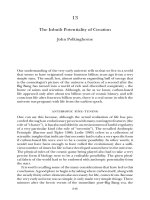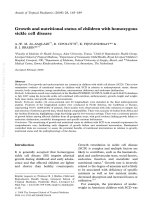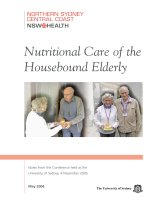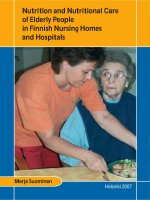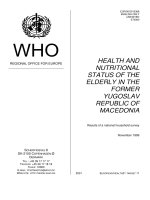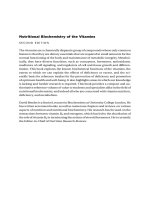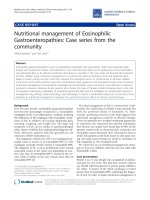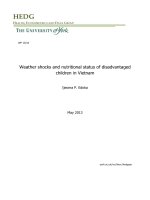Nutritional potentiality of earthworm perionyx
Bạn đang xem bản rút gọn của tài liệu. Xem và tải ngay bản đầy đủ của tài liệu tại đây (133.43 KB, 7 trang )
Seediscussions,stats,andauthorprofilesforthispublicationat:
/>
Nutritionalpotentialityofearthworm
(Perionyxexcavatus)forsubstituting
fishmealusedinlocalfeedcompanyin
Bangladesh
Article·October2010
CITATIONS
READS
8
220
3authors,including:
AbulFarahMd.Hasanuzzaman
MousumiDas
KhulnaUniversity
BangabandhuSheikhMujiburRah…
31PUBLICATIONS90CITATIONS
4PUBLICATIONS9CITATIONS
SEEPROFILE
SEEPROFILE
Someoftheauthorsofthispublicationarealsoworkingontheserelatedprojects:
DevelopmentofLow-costFeedforPabda(Ompokpabda)usinglocallyAvailable
IngredientsViewproject
AllcontentfollowingthispagewasuploadedbyAbulFarahMd.Hasanuzzamanon27May2014.
Theuserhasrequestedenhancementofthedownloadedfile.
Mesopot. J. Mar. Sci., 2010, 25 (2): 134 - 139
Nutritional potentiality of earthworm (Perionyx
excavatus) for substituting fishmeal used in local
feed company in Bangladesh
A.F.Md. Hasanuzzaman1*, Sk.Z. Hossian1 and M. Das1
1
Fisheries and Marine Resource Technology Discipline, Khulna University,
Khulna-9208, Bangladesh.
*email:
(Received: 26 May 2010 - Accepted: 4 October 2010)
Abstract - Nutritional composition of wild earthworm (Perionyx
excavatus) and fishmeal used by local fish-feed industry in
Bangladesh was determined to evaluate the nutritionally
replacement potentiality of this earthworm species for fishmeal
mostly used in feed for aquaculture and other animal production.
Except for moisture content, the proximate chemical values in P.
excavatus did not differ significantly (P≥0.05) from that in
fishmeal. On an average, the earthworm had lower protein
content (46.57 ± 0.97%) than fishmeal had (54.97 ± 7.49 %). On
the other hand, the mean lipid content (8.03 ± 0.44 %) in this
earthworm was found to be higher compared to fishmeal (7.97 ±
1.60 %). The average ash content in the earthworm and fishmeal
were 24.26 ± 0.68 % and 24.13 ± 8.44 %, respectively. The results
of the present study indicate that this earthworm species had
almost similar nutritional values to the fishmeal, and thus would
be a potential source of animal protein in supplementing
fishmeal. In an implication, year-round production of this
earthworm species through standard mass culture system, and its
radical use could play a pivotal role in sustainable fisheries and
aquaculture production.
Keywords: Earthworm, fishmeal, animal nutrition, sustainable
aquaculture.
Introduction
In commercial aquaculture ventures, feeding high-value finfish and
crustacean species is one of the most concerns focusing on availability of
feed stuffs, their nutritional quality, cost and economic returns. Among fishfeed stuffs, trash fish/low-value fishes are used as whole or chopped in wet
form, through fishmeal and fish-oil in commercial pelleted feed, and
sometimes as live fish. Generally, feed and fertilizers account for about 4060% of the total operational cost in semi-intensive aquaculture systems but
feed accounts for 60-80 % (FAO, 2007), and fishmeal makes up a
substantial stake of the cost. Traditionally fish meal is widely used as the
commonest and most popular protein source for compound aquafeed
production. About 3.06 million tones of fishmeal were consumed by
aquaculture sector in 2006 (Tacon, 2007). It is estimated that an
approximate 5 to 6 million tones of low - value/trash fish are used as direct
135
A.F.Md. Hasanuzzaman, Sk.Z. Hossian and M. Das
feed in aquaculture world-wide (Tacon et al., 2006). Watanabe (2002)
predicted that the demand for fish meal and fish oil would increase by more
than 300% over the next 10 years. In Bangladesh, feed manufacture
companies uses fishmeal collected locally and/or imported from China,
Thailand, and India. It is now in question if fishmeal produced from
dwindled capture fisheries would be sufficiently enough to supply the
growing demand for increasing aquaculture production. Moreover, fishmeal
is produced from low-value small fishes which are an important diet source
for poor people, especially riverside and coastal communities in Asia and
Africa. With taking into account of sustainable and ethical perspectives, it is
very coherent to find alternative feed ingredients (especially protein
sources) to make aquaculture economically viable and sustainable venture.
Earthworm has been found to be a good source of protein (Sogbesn and
Ugwumba, 2008; Kostecka and Pączka, 2006; Guererro, 1983; Hilton,
1983; Tacon et al., 1983), and its usage as fish bait is well known in fishing
(Omorinkoba et al., 1985; Segun, 1978). Earthworms with an important
high protein component are used to feed chickens, pigs, rabbits, and as a
dietary supplement for fish species (Mason et al., 1992; Sabine, 1986;
Stafford and Tacon, 1985; Akiyama et al., 1984). Among 36 earthworm
species available in Bangladesh, Perionyx excavatus - an epigeic
earthworm, is almost found throughout the year, and is a suitably potential
species for feeding roosters and fishes (Ali, 2002). The high reproductive
rate and biomass production of this tropical earthworm species make it
ideally suited to worm meal production (Edwards and Niederer, 1988).
Apart from availability, nutritional value of this earthworm is a major
prerequisite in serving as fishmeal substitution in feed production. With a
view to evaluating the nutritional suitability of P. excavatus, a comparative
study was conducted focusing on the proximate chemical composition of
wild P. excavatus and fishmeal used in local feed mill in Bangladesh.
Materials and Methods
A total of 90 wild earthworm species (Perionyx excavatus) was
collected from Khulna University Campus in Bangladesh, and eight samples
of fishmeal were colleted from two different animal feed companies, namely
Bay Agro Industries Limited and Aman Feed Company Limited in
Bangladesh. The proximate composition in content value of moisture, crude
protein, crude fat, and crude ash in earthworm species and fishmeal
samples was determined according to the methods of AOAC (2000). For
statistical analysis, fishmeal samples from two different feed companies
were pooled, and all data were subjected to two independent t-test at 5%
significance level to figure out differences in mean proximate composition
values between earthworm and fishmeal.
Results
The crude protein, lipid and ash content in Perionyx excavatus were
recorded to be ranged from 45.60 to 47.53 %, 7.59 to 8.47 % and 23.54 to
Nutritional Potentiality of Earthworm (Perionyx excavatus)
136
24.88 %, respectively. On the other hand, fishmeal contained protein of
37.87 - 61.28 %, lipid of 4.13 - 8.88 % and 18.68 - 44.36 % ash (Table 1). The
earthworm species had significantly (P<0.05) higher moisture (67.84 74.08 %) values compared to fishmeal containing moisture of 8.26 – 31.53
%. The mean crude protein content in the wild earthworm was found to be
insignificantly lower than that in fishmeal. On the other hand, the lipid and
ash values in the earthworm were close to the values recorded in fishmeal.
Though there was no significant differences in protein, lipid and ash
contents between the wild earthworm and the fishmeal, the nutritional
values in fishmeal were rather inconsistent than in the earthworm.
Table 1. Proximate chemical composition of earthworm species (Perionyx
excavatus) and fishmeal used in local feed mill in Bangladesh.
Groups
Moisture
(%)
% Dry mater
Crude
Protein
(%)
Crude
Lipid
(%)
Crude
Ash
(%)
*Fishmeal
Fishmeal (Emperic Int.)
Fishmeal (Karnafully Fish Products)
Fishmeal (Karnafully Fish Products)
Fishmeal (Emperic Int.)
Fishmeal (Emperic Int.)
Fishmeal (Tazan Agro Limited)
Fishmeal (Emperic Int.)
Fishmeal (Aman Feed Limited)
9.20
56.71
8.63
20.00
8.53
53.88
8.88
24.45
8.75
53.54
9.15
23.83
8.95
56.32
8.56
22.28
8.60
60.45
8.30
18.68
8.26
59.72
8.25
20.02
9.30
61.28
7.85
19.42
31.53
37.87
4.13
44.36
11.64a
54.97a
7.97a
24.13a
Mean ± SD
± 8.04
± 7.49
± 1.60
± 8.44
Earthworm (Perionyx excavatus)
71.53b
46.57a
8.03a
24.26a
Wild-caught (mean ± SD)
± 3.27
± 0.97
± 0.44
± 0.68
* Supplier names in parentheses; Fishmeal and earthworm groups with
different superscripts in the same column are significantly different
(P<0.05).
Discussion
Recently, nutritional value of earthworms has considerably taken
attention of fish nutritionists as they search for alterative animal protein
source to fishmeal which is characterized by seasonal availability, and
inconsistent supply from world’s dwindled fisheries stock. Protein quality of
earthworm has been reported at par with that of fishmeal (Sogbesan et al.,
2007; Kostecka and Pączka, 2006; Dynes, 2003). In the present research,
the crude protein, lipid and ash values of P. excavatus were recorded not to
be significantly different from that of fishmeal.
137
A.F.Md. Hasanuzzaman, Sk.Z. Hossian and M. Das
Though the crude protein content in P. excavatus was lower than 69.8
% (Guerrero, 1983) and 63.04 % for Hyperiodrilus euryaulos (Sogbesan et
al., 2007), the crude lipid value was higher than 5.8 % by Guerrero (1983),
7.8 % for Eisenia foetida (Tacon, 1994) and 5.9 % for H. euryaulos
(Sogbesan et al., 2007). The ash content was also found to be higher than
8.9 % for earthworm meal by Sogbesn and Ugwumba (2008) but lower than
45.7 % for wild Lumbricus terrestris (Barker et al., 1998). These variations
in proximate compositions are likely to be associated with specific-ecology,
food, seasons, life stages, and reproductive states etc. reported by Mason et
al. (1990) and Pennino et al. (1991).
The present work shows that fishmeal used in Bangladesh had almost
similar values for protein, lipid and ash contents as to the report by Khatoon
et al. (2006) and Sogbesan et al. (2007). But the quality of fishmeal is often
questioned with the presence of sand, stone, heavy metals, antibiotics, fine
sawdust, poultry byproducts and tannery wastes.
With considering the above facts, the present nutritional comparative
study implies that P. excavatus could be an excellent protein source of
substituting fishmeal used in fish-feed. The protein value of this earthworm
species was found within range of the protein requirement (35 – 50 %) for
aquaculture diets. The implicit significance of the present study is that P.
excavatus can be used as live food for fish and as feed ingredients for fishfeed. In addition, the potential usage of earthworm in aquaculture and other
animal production would contribute to the livelihoods of poor marginal
farmers in developing countries. However, further research works on
different contexts i.e. amino acid and fatty acid profile of this earthworm,
cost-effective mass culture technology, as well as fishmeal replacement
feasibility considering palatability, food conversion ratio (FCR) and
processing techniques are recommended.
Acknowledgement
The authors would like to express gratitude towards Aman Feed
Limited and Bay Agro Industries Limited for providing fishmeal samples
and relevant information during the study period.
References
Akiyama, T., Murai, T., Hirasawa, Y. and Nose, T. 1984. Supplementation of
various meals to fish meal diet for chum Salmon fry. Aquaculture, 37:
217-222.
Ali, M.S. 2002. Krishi O Poribesh Byabosthaponai Lagshai-Tekshoi Kencho
Prozukti. Uttyoron Offset Printing Press, Rajshahi, Bangladesh.
AOAC (Association of Official Analytical Chemists). 2000. Official Methods
of Chemical Analysis. 17th Edition, Washington, DC., USA.
Barker, D., Fitzpatrick, M.P., and Dierenfeld, E.S. 1998. Nutrient
composition of selected whole invertebrates. Zoo Biology, 17: 123-134.
Dynes, R.A. 2003. Earthworms-Technology information to enable the
development of earthworm production. Rural Industrial Research
Development Corporation Publication No. 03/085, 23 September
2003, pp: 1-3.
Nutritional Potentiality of Earthworm (Perionyx excavatus)
138
Edwards, C.A. and Niederer, A. 1988. The production and processing of
earthworm protein. In: C.A. Edwards and E.F. Neuhauser (Eds.)
Earthworms in waste and environmental management. Academic
Publishing, The hague, The Netherlands, pp. 169-180.
FAO (Food and Agriculture Organization of the United Nations). 2007.
Foreword. pp. xi-xii. In: M.R. Hasan, T. Hecht, S.S. De Silva, and
A.G.J. Tacon (Eds.) Study and analysis of feeds and fertilizers for
sustainable aquaculture development. FAO Fisheries Technical Paper.
No. 497. Rome, 510 pp.
Guerrero, R.D. 1983. The culture and use of Perionxy excavatus as protein
resource in the Philippines. In: J.E. Satchell (Ed.) Earthworm
Ecology, Chapman and Hall, London: 309-319.
Hilton, J.W. 1983. Potential of freeze-dried worm meal as a replacement for
fishmeal in trout diet formulations. Aquaculture, 32: 227-283.
Khatoon, S., Hanif, N.Q. and Malik, N. 2006. Status of fish meal available
for poultry rations In Pakistan. Pakistan Veterinary Journal, 26(2):
97-98.
Kostecka, J. and Pączka, G. 2006. Possible use of earthworm Eisenia fetida
(Sav.) biomass for breeding aquarium fish. European Journal of Soil
Biology, 42: S231-S233.
Mason, L.J., Johnson, S.J. and Woodring, J.P. 1990. Influence of age and
season on whole body lipid content of Plathypena scabra
(Lepidoptera: Noctuidae). Environmental Entomology, 19:1259-1262.
Mason, W.T., Rottmann, R.W. aand Dequine, J.F. 1992. Culture of
earthworms for bait or fish food. Florida Cooperative Extension
Service, Institute of Food and Agricultural Sciences, University of
Florida 1053, pp. 1-4.
Omorinkoba, W.S., Bankole, N.O. and Ita, E.O. 1985. A preliminary report
on earthworm culture for sport fishing in Kainji Lake Research
Institute (KLRI) reservoirs. KLRI Annual Report 1986, pp. 62-65.
Pennino, M., Dierenfeld, E.S. and Behler, J.L. 1991. Retinol, α-tocopherol,
and proximate nutrient composition of invertebrates used as feed.
International Zoo Yearbook, 30:143-149.
Sabine, J.R. 1986. Earthworms as a source of food and drugs, in:
Earthworm ecology from Darwin to Vermiculture, Chappman and
Hall, London, New York, pp. 285-296.
Segun, O.A. 1978. Eudrilid Earthworms from Ile-Ife, Western Nigeria. J.
Natural History, 12: 15-31.
Sogbesan, A.O. and Ugwumba, A.A.A. 2008. Nutritional values of some
non-conventional animal protein feedstuffs used as fishmeal
supplement in aquaculture practices in Nigeria. Turkish Journal of
Fisheries and Aquatic Sciences, 8: 159-164.
Sogbesan, A.O., Ugwumba, A.A.A. and Madu, C.T. 2007. Productivity
potentials and nutritional values of semi-arid zone earthworm
(Hyperiodrilus euryaulos; Clausen, 1967) cultured in organic wastes
as fish meal supplement. Pakistan Journal of Biological Sciences,
10(17): 2992-2997.
139
A.F.Md. Hasanuzzaman, Sk.Z. Hossian and M. Das
Stafford, E.A. and Tacon, A.G.J. 1985. The nutritional evaluation of dried
earthworm meal included at low level in production diets for
rainbrow trout, Salmo gairdneri, Richardson. Aquaculture and
Fisheries Management, 16: 213-222.
Tacon, A.G.J. 1994. Feed ingredients for carnivorous fish species.
Alternatives to fishmeal and other fishery resources. FAO of United
Nations, Fisheries Circular No.881. FIRI/C881, Rome, 35 pp.
Tacon, A.G.J. 2007. Meeting the feed supply challenges. Paper presented at
the FAO Globefish Global Trade Conference on Aquaculture.
Qingdao, China, 29-31 May 2007.
Tacon, A.G.J., Stafford, E.A. and Edwards, C.A. 1983. A preliminary
investigation of the nutritive value of three terrestrial lumbricid
worms for rainbow trout. Aquaculture, 35:187–199.
Tacon, A.G.J., Hasan, M.R. and Subasinghe, R.P. 2006. Use of fishery
resources as feed inputs for aquaculture development: trends and
policy implications. FAO Fisheries Circular. No. 1018. Rome, FAO. 99
pp.
Watanabe, T. 2002. Strategies for further development of aquatic feeds.
Fisheries Science, 68: 242-252.
View publication stats
